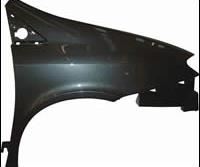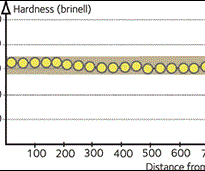How to Select the Right Steel Grade to Improve Mold Performance
A look at an improved steel grade utilizing boron metallurgy that will help shops reduce internal costs and minimize the risk of failure during manufacturing.
The vast majority of molds for the plastic injection molding industry have been traditionally made of conventional steel grades—such as AISI P20—but an alternative steel1 that uses an innovative metallurgy very different from that of the family of AISI P20 was developed to break the mold of material for mold manufacture with the intention of satisfying the specific needs of the plastics industry.
Conventional steels draw their characteristics from the hardening effect of carbon combined with elements—such as chromium or molybdenum. Although giving satisfactory results for several decades, with new polymers being introduced to the market and increased requirements on tools, these materials started to show their limits: closer inspections pointed out a consistent drop in hardness in the middle of thick blocks, which depending on the application was not acceptable.
| Figure 1 | |||||
| Chemistries |
C
|
Ni
|
Cr
|
Mo
|
Others
|
| AISI P20 |
0.35
|
(1.0)
|
1.8
|
0.40
|
-
|
| Steel Grade Light on Carbon and Prehardened to 300 HB |
0.25
|
-
|
1.3
|
0.4
|
Boron
|
| Chemistry comparison. Figures courtesy of Industeel. | |||||
On top of that, moldmakers have been facing a variety of problems during machining—such as hard spots during gun drilling, strong vibrations during milling, etc. Therefore, carbon-based metallurgy does not prove to be the best choice any more. Shops need to reduce internal costs while keeping their good reputation and position in the market place. In order to succeed, they have to minimize the risk of failure during manufacturing. For moldmakers and molders one of the contributing factors is choosing an improved steel grade.
The Carbon Challenge
Since carbon is responsible for the weaknesses of P20-type steels, one solution is to limit the carbon content to the minimum possible—without having to make up for this reduction by significant addition of expensive alloying elements such as nickel, chromium or molybdenum.
| Figure 3 | ||
|
P20 |
Steel Grade Light on Carbon and Prehardened to 300 HB
|
|
| Cutting speed (Vc (in/min) |
4920
|
5905
|
| Feed – fz (in/tooth) |
0.024
|
0.029
|
| Axial depth – ap(in) |
0.12
|
0.12
|
| Radial depth ae (in) |
2.95
|
2.95
|
| Machining parameters. | ||
The alternative is utilizing boron metallurgy. Added in small quantities, boron guarantees levels of hardness of 300 HB with excellent homogeneity—even for 800 mm (31.5") thick blocks. Years of research on how to optimize its benefits lead to this improved grade of steel (see Figures 1 and 2).
Effects of Metallurgy
Since metallurgy is only the means, it is of utmost importance to be interested in its effects.
Machinability
The first argument for the use of a steel grade light on carbon and prehardened to 300 HB is improved machinability and the related cost reduction.
A trial with a car fender mold resulted in a reduction in roughing time of 33 percent. The operation was performed in 60 hours with conventional steel and was reduced to 40 hours with the use of a steel grade light on carbon and prehardened to 300 HB. The final result was a substantial reduction in machining cost (see Figures 3 and 4).
Homogeneity
Improved homogeneity is another advantage, which manifests itself, on one hand with the absence of low hardness in mid-sections, but also importantly with the absence of hard spots that cause drills to break during gun drilling, and surface defects during chemical etching operations and polishing.
Hard spots (also called segregations) are areas with increased carbon content, which form during solidification of liquid steel. The advantage of having a grade light on carbon seems to be obvious. These segregations—which are much harder than the rest of material—can create deviations of the polished surfaces as well as waves, especially visible on pieces with large surfaces (see Figure 5).
This type of defect is most visible after painting, so it directly affects the body pieces. Using a steel grade light on carbon and prehardened to 300 HB for molds on automobile body pieces allows for perfect geometry of the surface of the pieces.
Weldability and Thermal Conductivity
Other advantages include improved weldability as well as a 15 to 20 percent improved thermal conductivity in comparison with conventional P20 grades. Improved thermal conductivity can bring significant contributions in reduction of injection cycle times; however, such potential might be slightly diminished in the case of poor thermal conductivity of the plastic itself (thick wall section), lack of contact between the steel and plastic (flat plastic pieces) or any problem related to cooling channels or their plugging.
Summary
As moldmakers and molders seek alternative mold materials to improve performance and reduce costs, a look at the machinability, homogeneity, weldability and thermal conductivity characteristics of any mold material is key to finding the right solution. Improved steel grades light on carbon (with a boron metallurgy instead) and prehardened to 300 HB offer the benefits for which today’s shops are searching.
References
1 Superplast® 300(P), Patented Superplast® 300, prehardened to 300 HB. Superplast® products are available in blocks from 20 mm (0.75”) up to 810 mm (32”) thick, and are distributed in North America by the Burger Iron Company (BICO) and Sturdell Industries, Inc. ® Industeel Trademark. (P) Patented grade.
Related Content
Laser Welding Versus Micro Welding
The latest battle in finely detailed restoration/repair of mold materials.
Read MoreHands-on Workshop Teaches Mold Maintenance Process
Intensive workshop teaches the process of mold maintenance to help put an end to the firefighting culture of many toolrooms.
Read MoreMaintaining a Wire EDM Machine
To achieve the ultimate capability and level of productivity from your wire EDM on a consistent, repeatable and reliable basis, regular maintenance is a required task.
Read MoreIt Starts With the Part: A Plastic Part Checklist Ensures Good Mold Design
All successful mold build projects start with examining the part to be molded to ensure it is moldable and will meet the customers' production objectives.
Read MoreRead Next
Breaking the H-13 Stereotype For the Common Mold
A look at the new grades and steel making practices that are available to address the day-to-day issues that occur in the operation of a mold.
Read MoreMaking the Most of High-Performance Mold Materials
Understanding high conductivity alloys and optimizing their use can help you build better molds.
Read MoreSpray-Formed Steels Help Moldmakers Meet New Demands
Advances in spray-formed steels help moldmakers meet increased demands on production lifetime of molds and other machine tools.
Read More










.jpg;maxWidth=300;quality=90)













